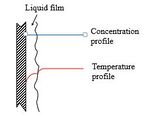Condensing heat transfer is important because many heat transfer applications will condense the steam used as the hot stream, and often gaseous products are needed in liquid form. There are two types of condenser: total condensers and partial condensers. Both total and partial condensers need to account for the accumulation of noncondensable vapor. This can be done by venting through the top of the exchanger. The tube bundle arrangement affects overall heat transfer as well. Falling condensate from higher to lower tubes increases local turbulence and thus the heat transfer coefficient. However, condensate that collects on a tube and has yet to drain prevents the cooled heat transfer surface from contacting the vapor.
Total Condenser

In a total condenser, all the vapor that enters is condensed as a film on the heat transfer surface. The heat transfer coefficient is determined only by the thermal resistances.
Partial Condenser

In a partial condenser, not all of the vapor that enters is condensed. This allows for vapor-liquid separation. However, there will be a a vapor film with a higher concentration of high-boiling products. The heat transfer coefficient is not determined solely by the thermal resistance, but also in part by the mass transfer resistance as well. The condensable component of vapor will have to diffuse through the noncondensable component. The resistance to diffusion leads to a much lower overall heat transfer coefficient. Additionally, it complicates the calculation of heat transfer.
Leave a Reply